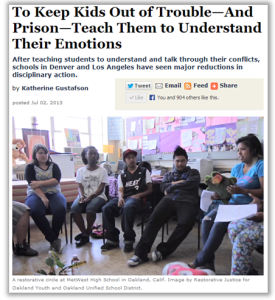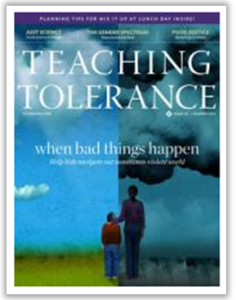Nonviolence Currents – Bridging Nonviolence and Current Events in the Classroom
A service of the Metta Center for Nonviolence
It’s summertime, and your school may not be in session, but right now, whether you are an educator or parent, you have probably been giving a lot of thought to Trayvon Martin, and your students or children may have lots of questions. The death of Trayvon, just a student himself, and the implications of George Zimmerman’s acquittal have had a large impact on our youth, and it’s important to seize this opportunity to have constructive dialogue about students’ feelings around the story, the questions they have, and what they can do to help create a peaceful society where stories like this don’t happen.
In this post, we’ll explore some ways to talk with youth about this issue, and we hope it inspires you to think of ways you can bring up this topic and surrounding issues in your classroom or home by asking critical questions with your students and working together to seek answers. As Teaching Tolerance’s Alice Pettway wrote in her blog post about Trayvon (which was written prior to the trial), “Some of these questions will be answered by investigators. Other questions—the deeper, more disturbing ones that ask about equality and intolerance—must be answered within our classrooms and our courtrooms.” But we now know it wasn’t answered in the courtroom, which leaves us to answer it in our classrooms, homes and communities.
Framing the issue around nonviolence
As educators, we can address this issue, the root causes, and solutions by teaching our students about nonviolence. A violent worldview teaches us that we are separate individuals who must fear others, and that violence is the only solution to our protection and security. Nonviolence teaches us that we are united in our diversity, and in using nonviolence we become closer in our relationships. Nonviolence offers alternatives to violent short-term “solutions,” and in exploring these alternatives, we empower our students to imagine and create a better world. Above all, you are teaching nonviolence when you work with your students to create a safe, nurturing space where they can explore these difficult questions and issues that affect their everyday lives.
Educator pre-reading
The readings and activities below are geared towards high school students. If you work with younger children, you may want to read Teaching About Trayvon Martin With Young Children on Teaching for Change – and even if you work with older students, this article will still give you some food for thought.
Read the blog Will We Learn from Trayvon Martin’s Death? on Teaching Tolerance by Alice Pettway. While the article was written before George Zimmerman was arrested and is thus lacking some updates on the Zimmerman arrest and trial, it gives plenty of inspiration for how you might begin to address this issue in the classroom. Pettway writes:
“Martin was not a victim of Zimmerman alone. He was a victim of the lopsided school system that suspended him. He was a victim of a police force that assumes first that young black men are guilty. He was a victim of legislation, like Florida’s Stand Your Ground law, that gives citizens the unfettered right to kill if they feel threatened in any way.
Tomorrow, look around your classroom. Do you have any Trayvon Martins? As an educator, you have the power to stave off the emptiness of Trayvon’s death. Talk to your students about racism. Question legislation that endorses vigilantism. Speak up against police inaction. Champion your students’ rights.”
Use Pettway’s words as inspiration for talking with your students and formulating your own ideas about how to address this complex topic with them. Before trying any of the ideas below, brainstorm your own ideas of how you might bring up the topics that Pettway mentions.
What do you know about the Trayvon Martin story? Getting the facts straight
As a class, do some research on the story. In small groups have students list what they already know about story. Then have each group research an article on the story and trial to confirm their facts and find new information, then report back to the class on their findings. Ask students to evaluate the news sources and what kind of perspective they generally take.
You may want to use CNN’s Trayvon Martin Shooting Fast Facts as a guide, and supplement this list with other sources.
Starting a Constructive Dialogue – Ask Questions
In addition to getting the facts straight, use this opportunity to brainstorm questions that your students have about Martin and Zimmerman and the larger issues at hand. Read the blog from Facing History and Ourselves for inspiration, and work with your students to brainstorm questions they have relating to this story. Then work together to answer these questions.
Gaining perspective – Circle of Truth Activity
Activity provided and created by Andre Brown, Metta community member and educator
This activity is a good follow-up to Getting the Facts Straight (above). To do this activity, make sure that you have already talked about the basic facts of the Martin & Zimmerman case.
Materials: you will need a set of index cards with the names George Zimmerman, Zimmerman’s Brother, Trayvon’s Friend Rachel Jeantel, and News Reporter (for example, Nancy Grace). The number of cards you need depends on your class size (for example, if you have 24 students you will need 6 sets of 4 cards). Alternatively, if you do not have index cards, you could have the class count off by four and assign each number a role.
- How did it feel to be someone that maybe you disagreed with or to take aside that you disagreed with?

- Was it easy or difficult to try to feel the feelings of someone else?
- What did you learn from this activity? Did this give you any new insights into the story of Trayvon Martin and George Zimmerman?
How can we create safe schools without suspensions? – Restorative Justice
Trayvon Martin was suspended from school at the time of his death – had he not been suspended, he might not have been in the situation that led to his death. An important aspect of nonviolence is constructive program, meaning we create alternative systems and institutions to replace the institutions and systems of violence and oppression. Restorative justice is a nonviolent and constructive alternative to the retributive justice system that prevails in many schools and in our criminal justice system.
As a class, read the article To Keep Kids Out of Trouble – and Prison – Teach them to Understand Their Emotions from YES! Magazine. Be sure to also watch the video at the end of the article, Restorative Justice in Oakland Schools. To deepen your exploration, use the Metta Center’s resources on restorative justice.
How can we create safe neighborhoods without using violence?
As as a class, read the article Fighting neighborhood crime, nonviolently by George Lakey on Waging Nonviolence. Discuss the example in the article of nonviolent neighborhood watch groups as an alternative to Florida’s Stand Your Ground law or other programs that promote the use of force as a safety mechanism. In addition to the above question, ask students what programs (if any) exist in their neighborhoods to promote safety, and whether these programs truly promote safety and security.

What does race have to do with it?
Return to the YES! Magazine article, which shows a graph on race and expulsion/suspension in schools in Texas, indicating that students of color are suspended at a higher rate than white students. Ask your students why they think this is happening.
Also, check out the following lessons on race from Teaching Tolerance:
Editorial Cartoon: RacismRacial Profiling Resources from the NAACP
What can we learn from Trayvon Martin’s Death? And what can we do?
These are perhaps the most important questions we can ask. While dialogue is an important starting point, outer transformation of our schools and communities will only flourish if we start to take action based on our discussions. Discuss these questions with your students, and based on their answers, come up with some tangible actions that you can take together such as:
-
Starting a restorative justice program or circle in your school
-
Starting a community nonviolent neighborhood watch group
-
Start a school Peace Team that will promote nonviolent resolution and transformation of conflicts in your school
If you try any of the activities above, or came up with your own ways of addressing these questions and issues with your students, we would love to hear from you! Please contact us at education@mettacenter.org.









